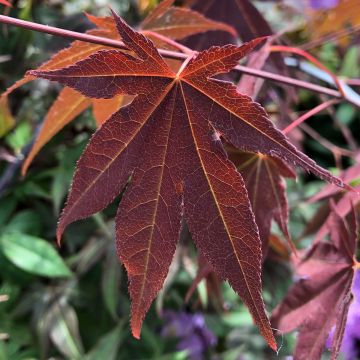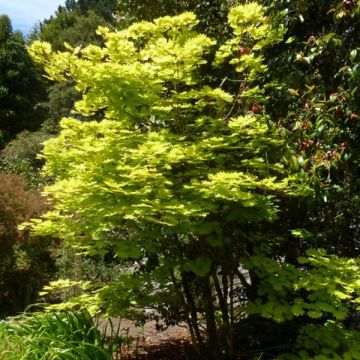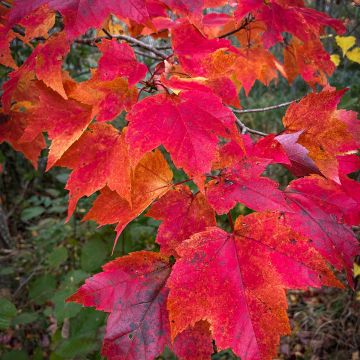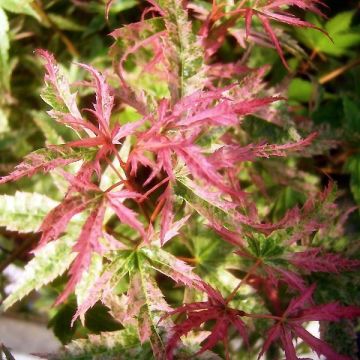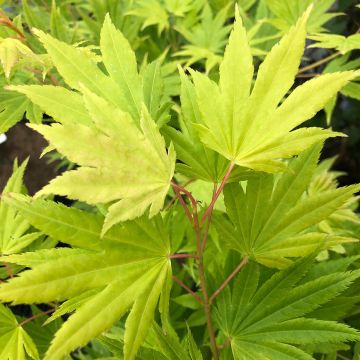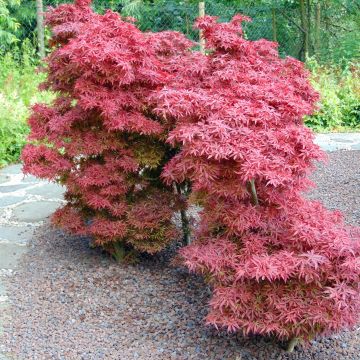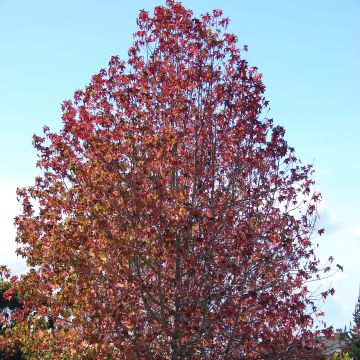

Acer pseudoplatanus Leat Cottage - Sycamore Maple


Acer pseudoplatanus Leat Cottage - Sycamore Maple
Acer pseudoplatanus Leat Cottage - Sycamore Maple
Acer pseudoplatanus Leat's Cottage
Sycamore, False plane.
Why not try an alternative variety in stock?
View all →This plant carries a 24 months recovery warranty
More information
We guarantee the quality of our plants for a full growing cycle, and will replace at our expense any plant that fails to recover under normal climatic and planting conditions.
Oversize package: home delivery by special carrier from €6.90 per order..
Express home delivery from €8.90.
Does this plant fit my garden?
Set up your Plantfit profile →
Description
Acer pseudoplatanus 'Leat Cottage' is a variety of Sycamore Maple appreciated for its compact size and foliage that changes colour throughout the seasons. Appearing in spring with a very attractive salmon pink foliage, the palmate leaves then evolve to yellow, and sometimes a light green that can even lean towards white. In autumn, the vegetation takes on orange hues before the leaves fall to the ground. An ideal deciduous tree for small gardens, where it will be highlighted when planted alone on a lawn.
The Maple is the main member of the Aceraceae family (now integrated into Sapindaceae), from which it derives its name (the only other genus being the little-known Dipteronia). The genus Acer includes at least 150 species, mostly trees, and sometimes shrubs, such as the delightful and popular Japanese Maples. Maples are recognised by their double samara fruits (the "helicopters" that amuse children), as well as their opposite leaves. All are deciduous, except for Acer sempervirens. The botanical Acer pseudoplatanus is a large European species reaching up to 30 m in height, and with good longevity (up to 500 years). It is found up to 1500 m altitude in the Alps, growing in fertile, moist soils. While it can develop in sunny exposure, it appreciates the semi-shade provided by forest edges.
'Leat Cottage' is a horticultural variety much more suitable for smaller gardens. This slow-growing, small tree reaches a height of only 4 to 5 m at maturity, forming an initially upright and conical crown, and then a more or less spherical crown with a diameter of 3.50 to 4.50 m, carried by a trunk with grey bark. In spring, the buds stretch before opening to reveal a bunch of small crumpled leaves, with a charming salmon-pink colour. They gradually open to take on their beautiful palmate shape, and their original colour persists for a few weeks. They then gradually evolve to a yellow mixed with pink, and turn into a rather bright whitish green, more or less green depending on the sunlight. The sun intensifies the colours, but can unfortunately cause scorching if it is too strong, so it will be necessary to choose a more or less shaded exposure depending on the region. The palmate leaf blades have five lobes, three main ones and two small lateral ones, and their margins are irregularly toothed. Due to the pale colour of the blade, the veins are clearly visible and enhance the leaf's design. Carried by long petioles, the leaves unfold their balanced proportions almost horizontally, creating pleasant see-through effects. They are variable in size, up to 15 cm in width and length and ornamental all year through to autumn when they take on an orange hue before falling to the ground.
The 'Leat Cottage' Maple will find a place in the smallest gardens thanks to its compact size, and can even be lightly pruned if necessary. Planting it alone on a lawn will allow you to fully appreciate its colour variations against a uniform background. You can also integrate it into a flowerbed, on the edge of large trees, and create beautiful colour contrasts. The year round golden foliage of Philadelphus coronarius 'Kostelec WB' will complement the foliage of your small Maple. This golden Mock Orange will also delight you with its highly fragrant white flowering in June. For a more powerful colour contrast, try Sambucus nigra 'Black lace', an Elderberry with beautifully cut foliage that creates an almost black mass, which will enhance the lighter colours of your small Maple. Its spring pink flowering is also very decorative. Another shrub with changing colours, Cotinus coggygria 'Old Fashioned' will surprise you with its rounded leaves that can be orange and purple or bluish depending on the season, a subtle association with 'Leat's Cottage'.
Report an error about the product description
Acer pseudoplatanus Leat Cottage - Sycamore Maple in pictures


Plant habit
Flowering
Foliage
Botanical data
Acer
pseudoplatanus
Leat's Cottage
Sapindaceae
Sycamore, False plane.
Cultivar or hybrid
Other Acer - Maple tree
Planting and care
Acer pseudoplatanus 'Leat Cottage' should be planted in spring or autumn in a deep, slightly moist soil, preferably without excessive limestone, in a moderately sunny or partially shaded location. Its colours are more beautiful in the sun, however, in very sunny regions, it should be placed in partial shade, as its variegated foliage is sensitive to scorching sun that can burn it. It is perfectly hardy, tolerating temperatures down to about -30°C. However, strong winds can damage its beautiful foliage. Keep the soil moist during the first two summers after planting. Mulching can be beneficial to maintain soil moisture, depending on the climate. Pruning is not necessary, simply remove dead wood in spring.
Canker is the main disease that affects maples.
Planting period
Intended location
Care
This item has not been reviewed yet - be the first to leave a review about it.
Striking foliage shrubs
Haven't found what you were looking for?
Hardiness is the lowest winter temperature a plant can endure without suffering serious damage or even dying. However, hardiness is affected by location (a sheltered area, such as a patio), protection (winter cover) and soil type (hardiness is improved by well-drained soil).

Photo Sharing Terms & Conditions
In order to encourage gardeners to interact and share their experiences, Promesse de fleurs offers various media enabling content to be uploaded onto its Site - in particular via the ‘Photo sharing’ module.
The User agrees to refrain from:
- Posting any content that is illegal, prejudicial, insulting, racist, inciteful to hatred, revisionist, contrary to public decency, that infringes on privacy or on the privacy rights of third parties, in particular the publicity rights of persons and goods, intellectual property rights, or the right to privacy.
- Submitting content on behalf of a third party;
- Impersonate the identity of a third party and/or publish any personal information about a third party;
In general, the User undertakes to refrain from any unethical behaviour.
All Content (in particular text, comments, files, images, photos, videos, creative works, etc.), which may be subject to property or intellectual property rights, image or other private rights, shall remain the property of the User, subject to the limited rights granted by the terms of the licence granted by Promesse de fleurs as stated below. Users are at liberty to publish or not to publish such Content on the Site, notably via the ‘Photo Sharing’ facility, and accept that this Content shall be made public and freely accessible, notably on the Internet.
Users further acknowledge, undertake to have ,and guarantee that they hold all necessary rights and permissions to publish such material on the Site, in particular with regard to the legislation in force pertaining to any privacy, property, intellectual property, image, or contractual rights, or rights of any other nature. By publishing such Content on the Site, Users acknowledge accepting full liability as publishers of the Content within the meaning of the law, and grant Promesse de fleurs, free of charge, an inclusive, worldwide licence for the said Content for the entire duration of its publication, including all reproduction, representation, up/downloading, displaying, performing, transmission, and storage rights.
Users also grant permission for their name to be linked to the Content and accept that this link may not always be made available.
By engaging in posting material, Users consent to their Content becoming automatically accessible on the Internet, in particular on other sites and/or blogs and/or web pages of the Promesse de fleurs site, including in particular social pages and the Promesse de fleurs catalogue.
Users may secure the removal of entrusted content free of charge by issuing a simple request via our contact form.
The flowering period indicated on our website applies to countries and regions located in USDA zone 8 (France, the United Kingdom, Ireland, the Netherlands, etc.)
It will vary according to where you live:
- In zones 9 to 10 (Italy, Spain, Greece, etc.), flowering will occur about 2 to 4 weeks earlier.
- In zones 6 to 7 (Germany, Poland, Slovenia, and lower mountainous regions), flowering will be delayed by 2 to 3 weeks.
- In zone 5 (Central Europe, Scandinavia), blooming will be delayed by 3 to 5 weeks.
In temperate climates, pruning of spring-flowering shrubs (forsythia, spireas, etc.) should be done just after flowering.
Pruning of summer-flowering shrubs (Indian Lilac, Perovskia, etc.) can be done in winter or spring.
In cold regions as well as with frost-sensitive plants, avoid pruning too early when severe frosts may still occur.
The planting period indicated on our website applies to countries and regions located in USDA zone 8 (France, United Kingdom, Ireland, Netherlands).
It will vary according to where you live:
- In Mediterranean zones (Marseille, Madrid, Milan, etc.), autumn and winter are the best planting periods.
- In continental zones (Strasbourg, Munich, Vienna, etc.), delay planting by 2 to 3 weeks in spring and bring it forward by 2 to 4 weeks in autumn.
- In mountainous regions (the Alps, Pyrenees, Carpathians, etc.), it is best to plant in late spring (May-June) or late summer (August-September).
The harvesting period indicated on our website applies to countries and regions in USDA zone 8 (France, England, Ireland, the Netherlands).
In colder areas (Scandinavia, Poland, Austria...) fruit and vegetable harvests are likely to be delayed by 3-4 weeks.
In warmer areas (Italy, Spain, Greece, etc.), harvesting will probably take place earlier, depending on weather conditions.
The sowing periods indicated on our website apply to countries and regions within USDA Zone 8 (France, UK, Ireland, Netherlands).
In colder areas (Scandinavia, Poland, Austria...), delay any outdoor sowing by 3-4 weeks, or sow under glass.
In warmer climes (Italy, Spain, Greece, etc.), bring outdoor sowing forward by a few weeks.





































